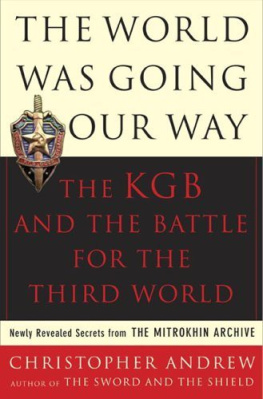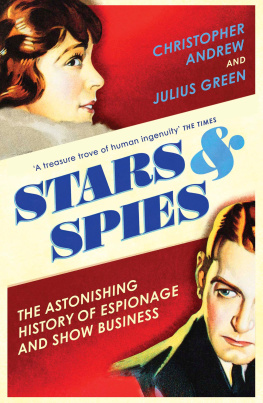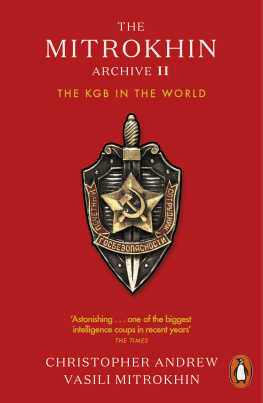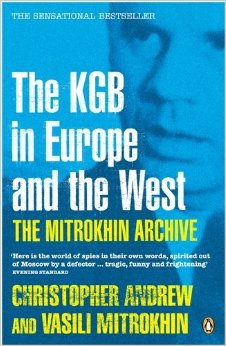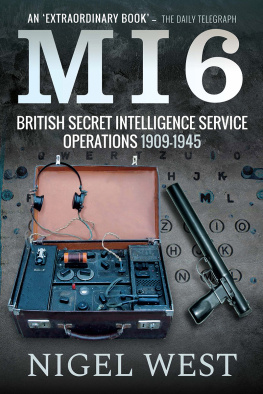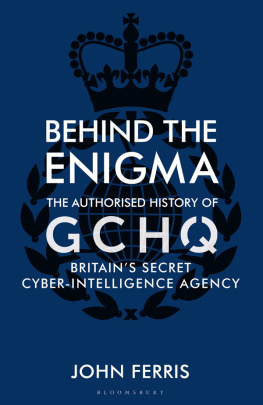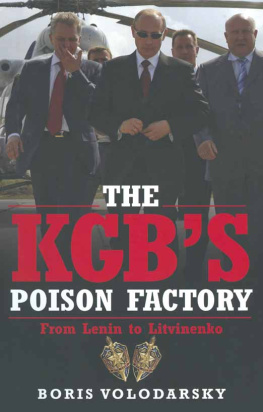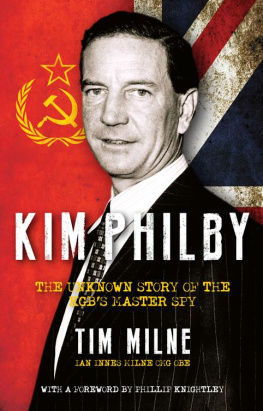Table of Contents
ALSO BY CHRISTOPHER ANDREW AND VASILI MITROKHIN
The Sword and the Shield: The Mitrokhin Archive
and the Secret History of the KGB
ALSO BY CHRISTOPHER ANDREW
Thophile Delcass and the Making of the Entente Cordiale
The First World War: Causes and Consequences
(Volume 19 of the Hamlyn History of the World )
France Overseas: The Great War and the Climax
of French Overseas Expansion
(with A. S. Kanya-Forstner)
The Missing Dimension: Governments and Intelligence
Communities in the Twentieth Century
(with David Dilks)
Her Majestys Secret Service: The Making of
the British Intelligence Community
Codebreaking and Signals Intelligence
Intelligence and International Relations 1900-1945
(with Jeremy Noakes)
KGB: The Inside Story of Its Foreign Operations
from Lenin to Gorbachev
(with Oleg Gordievsky)
Instructions from the Centre: Top Secret Files on
KGB Foreign Operations 1975-1985 (published in the USA as
Comrade Kryuchkovs Instructions )
(with Oleg Gordievsky)
More Instructions from the Centre: Top Secret Files on
KGB Global Operations 1975-1985
(with Oleg Gordievsky)
For the Presidents Eyes Only: Secret Intelligence and
the American Presidency from Washington to Bush
Eternal Vigilance? Fifty Years of the CIA
(with Rhodri Jeffreys-Jones)
ALSO BY VASILI MITROKHIN
KGB Lexicon: The Soviet Intelligence Officers Handbook (editor)

In Memory of
Vasili Nikitich Mitrokhin
(1922-2004)
and
Nina Mikhailovna Mitrokhina
(1924-1999)
The Evolution of the KGB, 1917-91
The functions, unlike the nomenclature, of the Soviet security and intelligence apparatus remained relatively constant throughout the period 1917-91. In recognition of that continuity, KGB officers frequently described themselves, like the original members of the Cheka, as Chekisty. The term KGB is sometimes used to denote the security and intelligence apparatus of the whole Soviet era, as well as, more correctly, for the period after 1954.
FOREIGN INTELLIGENCE
Founded in 1920, the foreign intelligence department of the Cheka and its inter-war successors was known as the Inostranni Otdel (INO). From 1941 to 1947 it was succeeded by the Inostrannoye Upravlenie (INU), also known as the First Directorate. From 1947 to 1951, the main foreign intelligence functions were taken over by the Komitet Informatsii (KI). From 1952 to 1991 foreign intelligence was run by the First Chief Directorate (save for the period from March 1953 to March 1954, when it was known, confusingly, as the Second Chief Directorate).
HEADQUARTERS
Foreign intelligence officers and directives to residencies referred to KGB headquarters as the Centre. In practice the Centre usually referred to the HQ of foreign intelligence rather than of the KGB as a whole. The organization of the KGB First Chief (Foreign Intelligence) Directorate is given in Appendix D.
KGB TERMINOLOGY
For detailed definitions, see Mitrokhin (ed.), KGB Lexicon .
Abbreviations and Acronyms
| AFSA | Armed Forces Security [SIGINT] Agency (USA) |
| ANC | African National Congress |
| ARA | American Relief Association |
| ASA | Army Security [SIGINT] Agency (USA) |
| AVH | Hungarian security and intelligence agency |
| AVO | predecessor of AVH |
| AWACS | airborne warning and control system |
| BfV | security service (FRG) |
| BND | foreign intelligence agency (FRG) |
| BNS | Bureau of National Security (Syria) |
| CCP | Chinese Communist Party |
| CDR | Committee for the Defence of the Revolution (Cuba) |
| CDU | Christian Democratic Union (FRG) |
| Centre | HQ of the KGB (or FCD) and their predecessors |
| Cheka | Vserossiiskaya Chrezvychainaya Komissiya po Borbe s Kontrrevolyutsiei i Sabotazhem: All-Russian Extraordinary Commission for Combating Counter-Revolution and Sabotage (predecessor of KGB (1917-22)) |
| CI | counter-intelligence |
| CIA | Central Intelligence Agency (USA) |
| CISPES | Committee in Solidarity with the People of El Salvador (USA) |
| COCOM | Coordinating Committee for East-West Trade (NATO and Japan) |
| Comecon | Council for Mutual Economic Assistance (Soviet bloc) |
| Comintern | Communist (Third) International |
| CPC | Christian Peace Conference |
| CPC | Communist Party of Canada |
| CPCz | Communist Party of Czechoslovakia |
| CPGB | Communist Party of Great Britain |
| CPI | Communist Party of India |
| CPJ | Communist Party of Japan |
| CPM | Communist Party of India, Marxist |
| CPSA | Communist Party of South Africa (later SACP) |
| CPSU | Communist Party of the Soviet Union |
| CPUSA | Communist Party of the United States of America |
| CSU | Christian Social Union (FRG; ally of CDU) |
| DCI | Director of Central Intelligence (USA) |
| Derg | Co-ordinating Committee of the Armed Forces, Police and National Guard (Ethiopia) |
| DGI | Direccin General de Inteligencia (Cuba) |
| DGS | Portuguese security service |
| DGSE | French foreign intelligence service |
| DIA | Defense Intelligence Agency (USA) |
| DISA | Direo de Informao e Seguranca de Angola |
| DLB | dead letter-box |
| DRG | diversionnye razvedyvatelnye gruppy : Soviet sabotage and intelligence groups |
| DRU | Direccin Revolucionaria Unida (El Salvador) |
| DS | Bulgarian security and intelligence service |
| DST | French security service |
| EPS | Ejrcito Popular Sandinista (Nicaragua) |
| F Line | Special Actions department in KGB residencies |
| FAPSI | Federalnoye Agentsvo Pravitelstvennoi Sviazi i Informatsii: Russian (post-Soviet) SIGINT agency |
| FBI | Federal Bureau of Investigation (USA) |
| FCD | First Chief [Foreign Intelligence] Directorate, KGB |
| FCO | Foreign and Commonwealth Office (UK) |
| FLN | Front de Libration Nationale (Algeria) |
| FMLN | Farabundo Mart de Liberacin Nacional (El Salvador) |
| FNLA | Frente Nacional de Libertao de Angola |
| FRAP | Frente de Accin Popular (Chile) |
| FRELIMO | Frente de Libertao de Moambique |
| FRG | Federal Republic of Germany |
| FSB | Federalnaya Sluzhba Bezopasnosti: Russian security and intelligence service |
| FSLN | Frente Sandinista de Liberacin Nacional (Nicaragua) |
| GCHQ | Government Communications Head-Quarters (British SIGINT Agency) |
| GDR | German Democratic Republic |
| GKNT | Gosudarstvennyi Komitet po Nauke i Tekhnologii: State Committee for Science and Technology |

